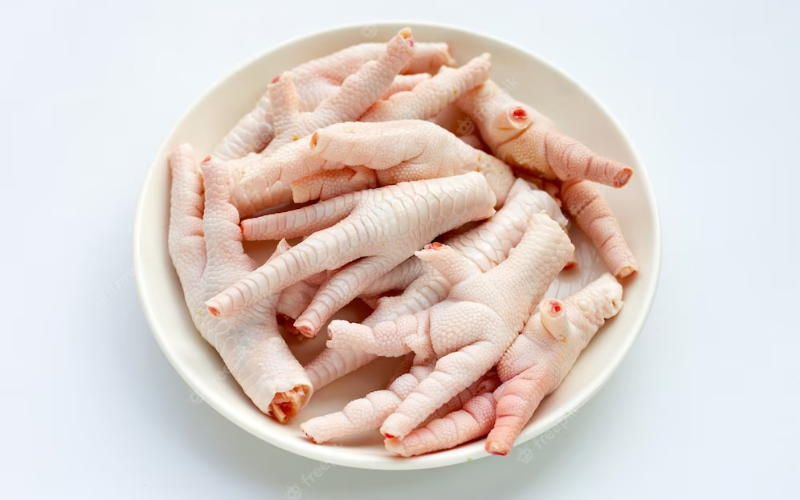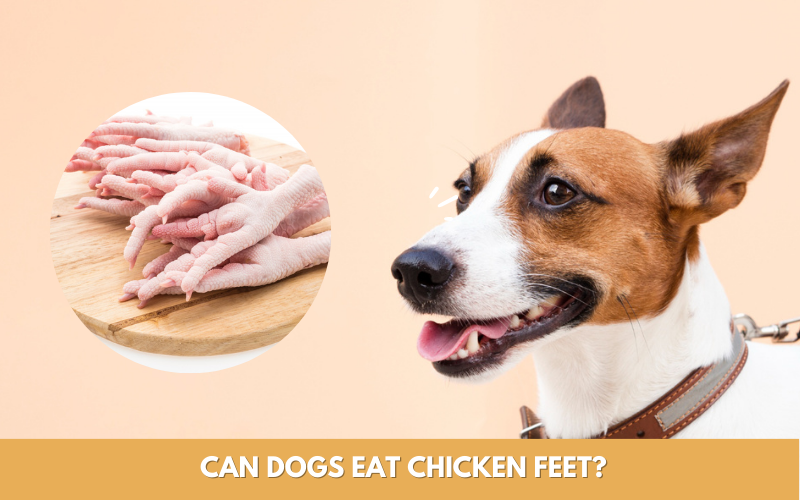Can dogs eat chicken feet? This is a common question among dog owners who are looking for healthy and nutritious treats for their furry friends. Chicken feet are a natural source of protein, minerals, and other important nutrients that can benefit dogs in many ways. They are also a popular treat in many cultures around the world. However, while chicken feet can be a healthy addition to a dog’s diet, there are some potential risks to be aware of, such as choking, bacterial contamination, and digestive issues. In this article, we will explore the benefits and risks of feeding chicken feet to dogs, as well as how to safely prepare and serve them as a treat.
Read more: Can Dogs Eat Chicken Safely? Here’s What You Need to Know
Overview of chicken feet for dogs

Chicken feet are a common ingredient in many traditional cuisines around the world. They are often used as a flavoring agent in soups, stews, and broths, and they are also enjoyed as a snack.
In recent years, chicken feet have become increasingly popular as a natural and nutritious treat for dogs. Chicken feet are high in protein, glucosamine, chondroitin, and minerals like calcium and phosphorus. They can help support joint health, promote healthy teeth and gums, and provide a satisfying chew for dogs.
However, it is important to choose the right type of chicken feet for dogs and to handle them safely to prevent any risk of bacterial contamination. Consulting with a veterinarian before adding chicken feet to your dog’s diet is also recommended.
Can dogs eat chicken feet?

The answer to Can dogs eat chicken feet is yes. However, they should only be given to your dog in moderation and must be cooked thoroughly first. Chicken feet are a natural source of glucosamine which is beneficial for joint health, as well as providing a range of other vitamins and minerals. When feeding your dog chicken feet, make sure to remove any excess fat and skin. Feed the feet raw or boil them in water to make them more palatable for your pet. If you want to offer your dog a special treat, you can even bake chicken feet with some nutritious ingredients like carrots and sweet potatoes.
As with all treats, it is important to remember that chicken feet should only be given in small amounts and should not be the main part of your dog’s diet. Always consult with your vet before introducing any new foods to your pet’s diet.
Can puppies eat chicken feet?
Yes, puppies can eat chicken feet, but it is important to take a few precautions. Puppies have developing teeth and jaws, so it is important to make sure that the chicken feet are not too hard for them to chew. Young puppies may also have a harder time digesting bones, so it is recommended to start with small amounts and gradually increase the serving size as your puppy grows.
Additionally, it is important to choose the right type of chicken feet for puppies and to handle them safely to prevent any risk of bacterial contamination. Consulting with a veterinarian before adding chicken feet to your puppy’s diet is also recommended to ensure that it is appropriate for their individual needs.
Are chicken feet good for dogs? What are the benefits?
Yes, chicken feet are good for dogs and offer many nutritional benefits. Here are some of the benefits of feeding dogs chicken feet:
- Promotes joint health: Chicken feet are rich in glucosamine and chondroitin, which are important nutrients for joint health. These nutrients can help reduce inflammation and promote healthy cartilage and joint function in dogs.
- Provides essential nutrients: Chicken feet are a good source of protein, calcium, phosphorus, and other minerals, which are essential for maintaining healthy bones, teeth, and muscles in dogs.
- Promotes dental health: Chewing on chicken feet can help remove plaque and tartar from your dog’s teeth, promoting better dental health and fresher breath.
- Helps with digestion: Chicken feet are high in gelatin, which can help soothe and heal the digestive tract. This can be especially helpful for dogs with digestive issues or sensitive stomachs.
- Provides mental stimulation: Chewing on chicken feet can provide mental stimulation and help alleviate boredom in dogs, which can help reduce destructive behavior and improve overall well-being.
In general, beside knowing can dogs eat chicken feet, you should know the benefits when feeding chicken feet to your pup. Chicken feet can be a nutritious and tasty snack for your dog. Make sure to choose the right type of chicken feet for your pet and handle them safely to prevent any risk of contamination. With proper care and moderation, chicken feet can be an enjoyable and beneficial treat for your canine companion.
Nutritional value in chicken feet
Chicken feet are a good source of several important nutrients that can provide various health benefits to dogs. Here are some of the nutritional values in chicken feet:
Here’s a table for the nutritional facts in chicken feet for dogs per 100 grams:
| Nutrient | Amount per 100g | % Daily Value | Benefits |
| Calories | 215 kcal | – | Provides energy to the body |
| Protein | 19 g | 38% | Helps build and repair tissues and muscles, essential for growth |
| Fat | 15 g | 23% | Provides energy, supports healthy skin and coat |
| Saturated fat | 3.9 g | 19% | Can increase cholesterol, but necessary for absorption of vitamins |
| Cholesterol | 84 mg | 28% | Can increase cholesterol, but necessary for hormone production |
| Potassium | 31 mg | 0% | Important for healthy muscles and nerve function |
| Sodium | 67 mg | 2% | Important for maintaining fluid balance and healthy cells |
| Total Carbohydrate | 0.2 g | 0% | No carbohydrates in chicken feet |
| Fiber | 0 g | 0% | No fiber in chicken feet |
| Sugar | 0 g | – | No sugar in chicken feet |
| Vitamin D | – | 2% | Important for bone growth and immune function |
| Iron | – | 4% | Essential for healthy blood cells |
| Calcium | – | 8% | Important for healthy bones and teeth |
| Cobalamin | – | 8% | Essential for the formation of red blood cells |
Where can you buy chicken feet for dogs?
You can buy chicken feet for dogs from a variety of sources, including:
- Local butcher or meat market: Many local butchers or meat markets carry chicken feet and other animal parts that are suitable for dogs.
- Pet stores: Some pet stores carry chicken feet and other natural treats for dogs.
- Online retailers: There are many online retailers that specialize in natural pet foods and treats, including chicken feet for dogs. Some examples include Chewy, Amazon, and Petco.
- Farmers markets: If you live in an area with a farmers market, you may be able to find chicken feet and other natural treats for dogs from local farmers or vendors.
When buying chicken feet for dogs, it is important to choose a reputable source that provides high-quality, safe, and natural products. It is also important to handle and store the chicken feet safely to prevent any risk of bacterial contamination.
Types of chicken feet for dogs

When feeding chicken feet to your dog, it is important to choose the right type. Here are some types of chicken feet that you should know when you want to feed your dogs:
Frozen chicken feet for dogs
Frozen chicken feet for dogss are a good option for those who prefer to feed raw chicken feet to their dogs. Freezing the chicken feet can help kill harmful bacteria, and it can also make the feet easier to handle and store. To feed frozen chicken feet to your dog, simply thaw them in the refrigerator or in a bowl of cold water. Always supervise your dog while they are eating the chicken feet and discard any uneaten portions to prevent bacterial contamination. It is also important to consult with a veterinarian before feeding your dog frozen chicken feet to ensure that it is appropriate for their individual needs.
Can dogs eat chicken feet raw?
Yes, dogs can eat raw chicken feet. Raw chicken feet are actually a popular and nutritious treat for dogs. They are high in protein, glucosamine, chondroitin, and minerals like calcium and phosphorus, which can help support joint health, promote healthy teeth and gums, and provide a satisfying chew for dogs.
However, it is important to handle raw chicken feet safely to prevent any risk of bacterial contamination. Raw chicken feet may carry harmful bacteria, so it is recommended to freeze them for at least 48 hours to reduce the risk of bacterial contamination before feeding them to your dog. Additionally, it is important to consult with a veterinarian before adding raw chicken feet to your dog’s diet to ensure that it is appropriate for their individual needs.
Dried chicken feet for dogs
Dried chicken feet are a popular and nutritious treat for dogs. They are made by dehydrating chicken feet, which removes the moisture content and preserves the nutrients. Dried chicken feet are low in fat and high in protein, and they can help promote healthy teeth and gums by providing a satisfying chew for dogs. They are also a good source of glucosamine and chondroitin, which can help support joint health in dogs. When buying dried chicken feet for your dog, it is important to choose a reputable source that provides high-quality, safe, and natural products.
Can dogs eat cooked chicken feet?
Yes, dogs can eat cooked chicken feet. Cooked chicken feet can be a great source of minerals like calcium and phosphorus, and can also provide a satisfying chew for dogs. However, it is important to make sure that the chicken feet are fully cooked before feeding them to your dog to prevent any risk of salmonella or other harmful bacteria.
Additionally, cooked chicken feet can be more brittle and prone to splintering than raw chicken feet, which can pose a choking hazard or cause digestive issues in some dogs. Always supervise your dog while they are eating cooked chicken feet and discard any uneaten portions to prevent choking or other digestive issues.
Can dogs eat boiled chicken feet?
Yes, dogs can eat boiled chicken feet. Boiling the chicken feet can help kill any harmful bacteria and make them easier to chew for your dog. However, it is important to make sure that the chicken feet are fully cooked before feeding them to your dog. Additionally, boiling may cause some of the minerals and nutrients in the chicken feet to leech out, which can reduce their nutritional value. To avoid choking or stomach disorders, observe your dog as they consume cooked chicken feet and remove any uneaten bits.
Smoked chicken feet for dogs
Smoked chicken feet for dogs are not recommended. While dogs can eat chicken feet in general, smoked chicken feet can be harmful to dogs because of the smoking process. The smoking process can add harmful chemicals and preservatives that can be toxic to dogs. Moreover, the high sodium content of smoked chicken feet can cause dehydration, which can be especially harmful for dogs with certain health conditions.
It is recommended to avoid feeding smoked chicken feet to dogs and to choose other types of chicken feet that are safe and beneficial for their health.
How to feed chicken feet to dogs?
Here are the steps to prepare chicken feet for dogs:
- Choose the right type of chicken feet: Make sure to choose high-quality chicken feet that are free from any added preservatives or chemicals.
- Clean the chicken feet: Rinse the chicken feet thoroughly under cold water to remove any dirt or debris. Use a small scrub brush to clean the crevices of the feet if necessary.
- Freeze the chicken feet: If you are planning to feed your dog raw chicken feet, it is recommended to freeze them for at least 48 hours to kill any harmful bacteria that may be present.
- Cook the chicken feet (optional): If you prefer to feed your dog cooked chicken feet, you can boil or simmer them for about 30-40 minutes until they are fully cooked.
- Serve the chicken feet: Once the chicken feet are prepared, you can serve them to your dog as a treat or as part of their regular diet. Make sure to supervise your dog while they are eating the chicken feet and discard any uneaten portions to prevent choking or other digestive issues.
When feeding chicken feet to your dog, it is important to consider their individual needs and dietary requirements. Consult your veterinarian for advice on the best ways to feed chicken feet to your dog. Additionally, always make sure that the chicken feet are high-quality and free from any added preservatives or chemicals. Following these steps can help ensure that you are providing your dog with a safe and nutritious treat.
How to store chicken feet for dogs?
Storing chicken feet for dogs is similar to storing other types of meat. Here are some tips on how to store chicken feet for dogs:
- Refrigeration: If you are planning to use the chicken feet within a few days, you can store them in an airtight container in the refrigerator. Make sure to place the container on the bottom shelf to prevent any drips or leaks.
- Freezing: If you have a large quantity of chicken feet or if you want to store them for a longer period of time, you can freeze them. Place the chicken feet in a freezer-safe bag or container, making sure to remove as much air as possible before sealing. Label the bag or container with the date and contents and store it in the freezer.
- Thawing: When you are ready to use the chicken feet, you can thaw them in the refrigerator or in a bowl of cold water. Make sure to use them within 24 hours of thawing to prevent any risk of bacterial contamination.
- Safety: It is important to handle chicken feet safely to prevent any risk of bacterial contamination. Always wash your hands thoroughly with soap and water before and after handling chicken feet and make sure to clean any surfaces or utensils that come into contact with them.
By following these tips, you can safely store chicken feet for your dog and ensure that they are fresh and nutritious when you are ready to use them.
What age can dogs eat chicken feet?
Dogs can generally start eating chicken feet at any age, but it is important to take certain precautions depending on their age and size. Here are some things to consider:
| Age of Dog | Can Dogs Eat Chicken Feet? |
| Puppies (up to 8 weeks) | No, it is not recommended to feed chicken feet to puppies under 8 weeks old. |
| Young Dogs (8 weeks to 6 months) | Yes, but it is important to start with small amounts and to monitor their chewing to ensure that the chicken feet are not too hard for their developing teeth and jaws. |
| Adult Dogs (6 months and older) | Yes, most adult dogs can safely eat chicken feet in moderation as part of a balanced diet. However, it is important to choose the right type of chicken feet and to handle them safely to prevent any risk of bacterial contamination. |
| Senior Dogs (7 years and older) | Yes, but it is important to consider any health issues that may affect their ability to chew or digest bones, and to consult with a veterinarian before feeding them chicken feet. |
Note: These age ranges are approximate and may vary depending on the individual dog’s size, breed, and health status. Consult with a veterinarian before adding chicken feet to your dog’s diet to ensure that it is appropriate for their individual needs.
How many chicken feet for dogs?

The number of chicken feet that a dog can eat depends on their size, age, and individual dietary needs. As a general guideline, here are some recommended serving sizes of chicken feet for dogs based on their weight:
- Small dogs (up to 10 lbs): 1-2 chicken feet per day
- Medium dogs (10-50 lbs): 2-3 chicken feet per day
- Large dogs (50+ lbs): 3-4 chicken feet per day
It is important to introduce chicken feet gradually into your dog’s diet and monitor their digestion and overall health. Feeding too many chicken feet or any other treat can lead to digestive issues or weight gain.
Potential risks of feeding dogs chicken feet
While chicken feet can be a healthy and nutritious treat for dogs, there are some potential risks to be aware of when feeding them to your furry friend. Here are some of the potential risks:
- Choking hazard: Chicken feet can pose a choking hazard, especially for small dogs or dogs that eat too quickly. It is important to supervise your dog while they are eating chicken feet and to discard any uneaten portions to prevent choking or other digestive issues.
- Bacterial contamination: Raw chicken feet may carry harmful bacteria, such as Salmonella or Campylobacter, that can cause illness in dogs and humans. It is recommended to handle raw chicken feet safely and to freeze them for at least 48 hours to reduce the risk of bacterial contamination. Cooked or dehydrated chicken feet may also carry a risk of bacterial contamination if not handled properly.
- Splintering: Chicken feet, especially cooked ones, can splinter and cause digestive issues, such as blockages or punctures in the digestive tract.
- High in sodium: Some chicken feet may be high in sodium, which can be harmful to dogs, especially those with certain health conditions.
- Nutritional imbalance: While chicken feet can be a healthy addition to a dog’s diet, feeding too many of them may lead to an imbalance in their overall nutritional intake.
Alternatives to feeding dogs chicken feet
If you are looking for alternatives to feeding your dog chicken feet, here are some other healthy and nutritious treats that you can offer:
- Raw bones: Raw bones, such as beef marrow bones or lamb ribs, can provide similar benefits to chicken feet. They are a natural source of minerals and can help clean your dog’s teeth and gums.
- Antlers or horns: Antlers or horns, such as deer antlers or water buffalo horns, are long-lasting chews that can keep your dog entertained for hours. They are also a natural source of minerals.
- Dehydrated treats: Dehydrated treats, such as beef liver or sweet potato chips, are low in fat and high in nutrients. They can be a healthy and tasty alternative to chicken feet.
- Fruits and vegetables: Many fruits and vegetables, such as carrots, blueberries, and green beans, are safe and healthy for dogs. They are low in calories and can provide important vitamins and minerals.
- Commercial dog treats: There are many commercial dog treats available that are specifically formulated to be healthy and nutritious for dogs. Make sure to choose high-quality treats that are made with natural ingredients and are free from additives or preservatives.
No matter what treats you choose for your dog, it is important to feed them in moderation and to always provide fresh water. Treats should never replace a balanced diet of healthy and nutritious meals. If you have any questions about feeding your dog chicken feet or other treats, consult with your veterinarian for personalized advice.
FAQs
Can chicken feet help with bad breath in dogs?
Yes, chicken feet can help improve bad breath in dogs by promoting healthy digestion and reducing bacterial buildup in the mouth.
Can chicken feet be used as a training treat?
Yes, chicken feet can be used as a high-value training treat for dogs. They are often very appealing to dogs and can be broken into smaller pieces for training purposes.
Are chicken feet a good option for dogs with allergies?
Chicken feet may be a good option for dogs with allergies to other types of meat, as they are a novel protein source. However, it is important to consult with a veterinarian before introducing chicken feet to a dog with food allergies.
Can chicken feet cause blockages in dogs?
Chicken feet can potentially cause blockages in dogs, especially if they are not chewed properly or if a dog eats too many at once. It is important to supervise your dog while they are eating chicken feet and to discard any uneaten portions to prevent choking or other digestive issues.
How long does it take for a dog to digest a chicken foot?
The digestion time for a chicken foot in dogs can vary depending on the dog’s size and individual digestion speed. In general, it may take anywhere from 12 to 24 hours for a dog to fully digest a chicken foot. It is important to monitor your dog’s digestion and overall health when introducing any new food to their diet.
Conclusion
Altogether, can dogs eat chicken feet? The answer is yes, but always do so with caution and under the guidance of a veterinarian. Chicken feet can be a healthy and nutritious treat for dogs when fed in moderation and prepared and handled safely. With proper preparation and monitoring, dogs can eat chicken feet as a tasty and beneficial treat. Always keep in mind that chicken feet should not replace a balanced diet and should be fed to your dog sparingly. If you have any questions or concerns about feeding chicken feet to your dog, consult with your veterinarian for personalized advice.

